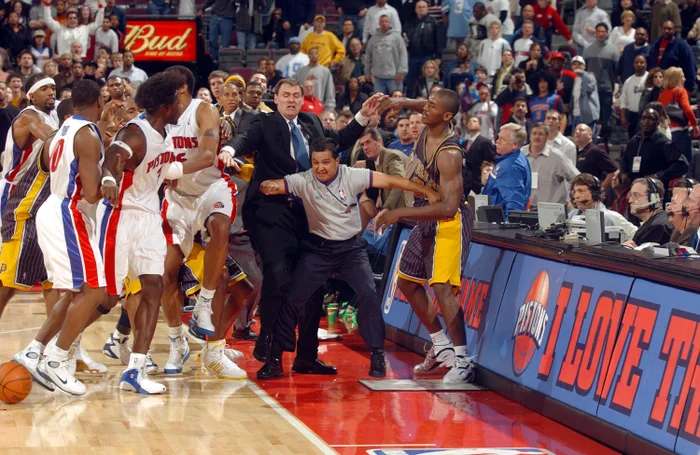Revisiting one of the most iconic nights in NBA history, a game that forever changed the league
Menu
Revisiting one of the most iconic nights in NBA history, a game that forever changed the league

It was November 19, 2004, an ordinary day for basketball. The Indiana Pacers and Detroit Pistons, two of the strongest teams in the Eastern Conference, were facing off at the Palace of Auburn Hills in Detroit. It was set to be another night of physical, competitive rivalry between two teams that would meet frequently in the playoffs. But what happened that night was marked as the moment the NBA lost control, and the game of basketball was never the same again. “Malice at the Palace” became synonymous with chaos, violence, and an era that was about to change.
It was the end of the game, with less than a minute left on the clock, and the Indiana Pacers were leading 97-82. The win was secure, but the tension was far from over. Ron Artest, one of the league’s most talented yet emotionally unstable players, was executing his usual style of defense—physical, provocative, and a headache for any opponent. In an attempt to guard Ben Wallace, one of the Pistons’ defensive icons, Artest committed a hard foul. Frustrated by the imminent loss and the unnecessary foul at the end of a decided game, Wallace retaliated by shoving Artest violently in the chest. That was the spark.
The court turned into a pushing and shoving match between players, reserves, and even members of the coaching staff. It was one of those moments when the pent-up tension from the season, the physical play, and the heated rivalry boiled over. But no one, absolutely no one, expected what would happen next.

While referees and coaches tried to calm things down, Ron Artest lay down on the scorers’ table, seemingly trying to keep his cool amid the chaos. What seemed like a moment of relaxation quickly became the spark for a wildfire. A Pistons fan threw a cup of beer that hit Artest in the chest. What followed was pure chaos: Artest jumped over the barrier separating players from fans and rushed into the stands, punching the fan he believed to be responsible.
That was enough to turn the arena into a battlefield. Fans got involved in the conflict, Pacers players climbed into the stands to protect Artest, and Pistons players tried to contain the chaos. The brawl extended to the court, with punches being exchanged between fans and players. Jermaine O’Neal, another Pacers player, landed a punch that nearly knocked out a fan who had invaded the court.
The “Malice at the Palace” was a turning point for the NBA. Images of players exchanging punches with fans became global headlines. NBA Commissioner David Stern acted quickly to contain the situation and imposed severe punishments to protect the league’s image. The consequences were staggering:
For the NBA, the impact was profound. The “Malice at the Palace” changed how the league was perceived, forcing an internal review of player behavior, arena environments, and the relationship between fans and players. New rules were quickly implemented to prevent any similar incidents:
The “Malice at the Palace” is still remembered as the moment the NBA was forced to confront its own issues. For the players, especially those directly involved, the incident redefined their careers. Ron Artest, once seen as one of the best defenders in the league, became a villain, a role he struggled to overcome for the rest of his career. Jermaine O’Neal and Stephen Jackson were forever associated with the incident, even as they tried to rebuild their reputations.
But beyond the punishments and new rules, the real legacy of the “Malice at the Palace” lies in the understanding that sports are more than just games. They are spectacles, stages of emotions, rivalries, and sometimes conflicts. The NBA learned its lesson and adapted, turning the incident into an opportunity for growth. And the players, the league, and the fans have never forgotten that night in Auburn Hills, when everything spiraled out of control, and the game became something much more than just a sport.
Jornalista em formação pela Unesp Bauru.
The project emerged in June 2024, in São Paulo, envisioned by four sports enthusiasts. We believe that every game, every competition, every moment is a story waiting to be written.
For us, sports are much more than numbers and statistics; it’s about people, dreams, and overcoming challenges. It is one of the purest forms of human connection. It’s the moment when the soul speaks, shouts, celebrates, and cries. A universal language that connects people of all ages and cultures.
At The Sports Context, we aim to offer a complete experience. We want to be your go-to place for news and analysis, fueling your conversations with friends at the bar, always with the quality and dedication that only true sports lovers can provide. Our mission is to create a space where sports are celebrated, discussed, and, above all, lived.
Join us on this journey and feel your heart beat faster with each story told. Here, sports come to life in every word.
Created by Estratégia Digital